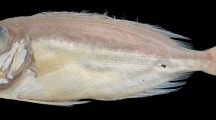Abstract
Over the past few decades, tool use has been described in a variety of animals across taxa. However, there are relatively limited reports and studies of tool use in marine environments. Among marine fish though, labrids have been reported to be proficient at using tools. Here, we describe the first observations of tool use in two species of tropical wrasses—Halichoeres hortulanus (checkerboard wrasse) and Thalassoma jansenii (Jansen’s wrasse)—and the first report of tool use from the wild for the wrasse Thalassoma lunare (Moon wrasse). These observations were made incidentally as part of size-specific predation assays for a small burrow-dwelling sea urchin (Echinostrephus molaris) in the Lakshadweep Archipelago, Indian Ocean. We documented multiple instances of anvil use by the wrasses H. hortulanus, and T. jansenii, and one instance of anvil use by T. lunare. All three species were recorded carrying the assay urchins to a nearby coral or benthic substrate and striking them repeatedly to break off their spines and crack their tests before consuming them. The behaviour was observed multiple times in different wrasse individuals. Also, sea urchin test size was a good predictor of the size of the fish that preyed on them. As naturalists spend more time observing fish in their natural environment, records of tool use in fish are increasing. Often these observations are incidental, yet documenting them carefully is critical, so we can ask larger questions about the evolution and development of animal intelligence. This study adds to observations of predation-associated tool use by fishes expanding reports of this behaviour taxonomically as well as geographically.



Similar content being viewed by others
Data availability
Data (associated videos) are available in Zenodo at https://doi.org/10.5281/zenodo.10444097
References
Beck BB (1980) Animal tool behavior: the use and manufacture of tools. Garland STPM Press, New York
Brown C (2012) Tool use in fishes. Fish Fish 13(1):105–115. https://doi.org/10.1111/j.1467-2979.2011.00451.x
Coghlan AR, Blanchard JL, Heather FJ, Stuart-Smith RD, Edgar GJ, Audzijonyte A (2022) Community size structure varies with predator–prey size relationships and temperature across Australian reefs. Ecol Evol 12(4):1–23. https://doi.org/10.1002/ece3.8789
Coyer JA (1995) Use of a rock as an anvil for breaking scallops by the yellowhead wrasse, Halichoeres garnoti (Labridae). Bull Mar Sci 57(2):548–549
Dunic JC, Baum JK (2017) Size structuring and allometric scaling relationships in coral reef fishes. J Anim Ecol 86(3):577–589. https://doi.org/10.1111/1365-2656.12637
Dunn RP (2016) Tool use by a temperate wrasse, California sheephead Semicossyphus pulcher. J Fish Biol 88(2):805–810. https://doi.org/10.1111/jfb.12856
Fricke HW (1971) Fische als Feinde tropischer Seeigel. Mar Biol 9(4):328–338. https://doi.org/10.1007/BF00372827
Harborne AR, Tholan BA (2016) Tool use by Choerodon cyanodus when handling vertebrate prey. Coral Reefs 35(3):1069. https://doi.org/10.1007/s00338-016-1448-6
Jones AM, Brown C, Gardner S (2011a) Tool use in the tuskfish Choerodon anchorago. Coral Reefs 30(3):865. https://doi.org/10.1007/s00338-011-0790-y
Jones AM, Brown C, Gardner S (2011b) Tool use in the tuskfish Choerodon schoenleinii? Coral Reefs 30(3):865. https://doi.org/10.1007/s00338-011-0790-y
Mann J, Patterson EM (2013) Tool use by aquatic animals. Philos Trans Roy Soc B Biol Sci 368(1630). https://doi.org/10.1098/rstb.2012.0424
Mihalitsis M, Bellwood DR (2017) A morphological and functional basis for maximum prey size in piscivorous fishes. PLoS ONE 12(9):1–19. https://doi.org/10.1371/journal.pone.0184679
Parenti P, Randall JE (2000) An annotated checklist of the species of the Labroid Fish families Labridae and Scaridae. Ichthyological Bull 68(January 2011).
Paśko Ł (2010) Tool-like behavior in the sixbar wrasse, Thalassoma hardwicke (Bennett, 1830). Zoo Biol 29(6):767–773. https://doi.org/10.1002/zoo.20307
Pryor KJ (2022) Tool use by the orange wrasse Pseudolabrus luculentus and doubleheader Coris bulbifrons. Mar Ecol 43(6):1–7. https://doi.org/10.1111/maec.12727
Scharf FS, Juanes F, Rountree RA (2000) Predator size - prey size relationships of marine fish predators: interspecific variation and effects of ontogeny and body size on trophic-niche breadth. Mar Ecol Prog Ser 208:229–248
Schneider CA, Rasband WS, Eliceiri KW (2012) NIH Image to ImageJ: 25 years of image analysis. Nat Methods 9(7):671–675. https://doi.org/10.1038/nmeth.2089
St Amant R, Horton TE (2008) Revisiting the definition of animal tool use. Anim Behav 75(4):1199–1208. https://doi.org/10.1016/j.anbehav.2007.09.028
Van Lawick-Goodall J (1971) Tool-using in primates and other vertebrates. Adv Study Behav 3(C):95–249. https://doi.org/10.1016/S0065-3454(08)60157-6
Acknowledgements
We are grateful to the National Centre for Biological Sciences (NCBS), Bangalore, The Habitats Trust (THT), Shri A.M.M. Murugappa Chettiar Research Centre, Rohini Nilekani Philanthropies, Cholamandalam Investment and Finance Company Limited, and Arvind Dattar for funding this project and providing academic and logistical support. The Spanish National Research Council supported T. Alcoverro through the Memorandum of Understanding between Centre D’Estudis Avançats de Blanes (CEAB, CSIC) and Nature Conservation Foundation (NCF). We would also like to thank the Department of Science and Technology (DST), and Forest and Environment Department, Lakshadweep, for their constant support and help in obtaining permits. A huge thank you to Wenzel Pinto and Mayukh Dey for assisting in the fieldwork and to Anwar, Aman, and Radheesh for their help in field work.
Funding
This work was supported financially and logistically by the National Centre for Biological Sciences (NCBS), Bangalore, The Habitats Trust (THT), Shri A.M.M. Murugappa Chettiar Research Centre, Rohini Nilekani Philanthropies, Cholamandalam Investment and Finance Company Limited, Arvind Dattar, Centre D’Estudis Avançats de Blanes (CEAB, CSIC) and Nature Conservation Foundation (NCF). The authors have no relevant non-financial interests to disclose.
Author information
Authors and Affiliations
Corresponding author
Ethics declarations
Conflict of interest
On behalf of all authors, the corresponding author states that there is no conflict of interest.
Additional information
Publisher's Note
Springer Nature remains neutral with regard to jurisdictional claims in published maps and institutional affiliations.
Supplementary Information
Below is the link to the electronic supplementary material.
Rights and permissions
Springer Nature or its licensor (e.g. a society or other partner) holds exclusive rights to this article under a publishing agreement with the author(s) or other rightsholder(s); author self-archiving of the accepted manuscript version of this article is solely governed by the terms of such publishing agreement and applicable law.
About this article
Cite this article
Jaishankar, S., Nair, R., Alcoverro, T. et al. Anvil use by three wrasse species: Halichoeres hortulanus, Thalassoma jansenii, and Thalassoma lunare. Coral Reefs 43, 483–487 (2024). https://doi.org/10.1007/s00338-024-02467-y
Received:
Accepted:
Published:
Issue Date:
DOI: https://doi.org/10.1007/s00338-024-02467-y




